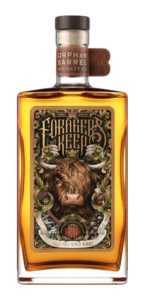By Andrew Graham
Rating: B
I tend to start with a distiller’s most basic, down-market whiskey. I figure if I don’t like a distiller’s entry-level dram, then I’m probably not going to love its more scarce bottlings.
So Forager’s Keep, the first single malt Scotch expression from Diageo’s Orphan Barrel series, isn’t something I would typically sit down and drink, for no other reason than the fact that Orphan Barrel doesn’t have an entry-point whiskey. But I’m glad that I did.
Launched in 2013, Orphan Barrel seems to exist primarily as a crafty way to commercialize certain stocks of old spirits from across the wide range of what Diageo owns. The concept is pretty simple: It’s all scarce stuff with marketable age statements, and once a particular expression of Orphan Barrel sells out, that’s it; it’s gone forever.
There is a good amount of history in this dram. What’s actually in a bottle of Forager’s Keep is a 26-year single malt expression from the Pittyvaich Distillery in Scotland, which closed in 1993 and was demolished in 2002. Pittyvaich, located in the Speyside region, was initially set up in the 1970s to meet Britain’s voracious demand for Bell’s Blended Whisky. It was operational for just 18 years, almost exclusively as a source of whisky for blends. In that era, single malts were not particularly popular; Scotch whisky drinkers were generally drinking blended Scotch.
Curiously, Forager’s Keep, like all of Orphan Barrel’s expressions, is bottled in Tennessee. It isn’t clear how much time, if any, it spends aging there, and I wouldn’t speculate on what affects, if any, the warmer climate in the States could have had on it.
All that aside, drinking the Forager’s Keep certainly is an experience. It is layered and balanced and hot enough, at 48% ABV, to impart what I imagine is the true flavor of whisky that’s not only just really hard to find now, but that wasn’t consumed as a single-malt when it was plentiful. It’s suggested retail price is also around $400 — still too pricey to be anything more than an occasional indulgence for me.
The Scotch
Color: Pale straw
Nose: I got a nose that implied both sweet and earthy qualities: maple syrup, caramel, wet sticks, moss. The sweet aromas were more subtle than what you’d get with, say, a sherry-finished expression.
Flavor: I registered rich notes of charred citrus, burnt honey, baking spice, and tobacco. The balance, marriage, and layering of the flavors in this dram are its most impressive attributes.
Finish: It’s a balanced finish that lets a good amount of peat cut ahead of those charred, slightly sweet flavors, which do linger. I got a finish reminiscent of burnt rope and figs.
The Price
The suggested retail price is $400.
 The Whiskey Reviewer A World of Whiskey, Poured Every Weekday
The Whiskey Reviewer A World of Whiskey, Poured Every Weekday


You mentioned Peat in the finish. Is this more of a peaty scotch?